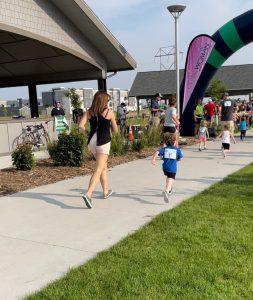I remember the first time my oldest son ran a road race. He was three years old. It was the youth run that was part of the former GoFar Woman event.
We lined up together at the start line for the half-mile distance and ran together the entire time — with a couple short breaks here and there to walk.
As a runner myself, this moment brought me pure joy. I was thrilled that he wanted to run. I had spent hours running with him, both before he was born and after. And I even trained for, and ran, a marathon when I was pregnant with him.
As “The Boss” Bruce Springsteen would say, he was, “Born to run.”

But two things never really dawned on me when we signed up to run that race together:
- Was he too young to do it?
- Was it too much for him?
When Should Kids Start Exercise?
There’s a lot of confusion around what is enough or too much for children when it comes to exercise, as well as what is age-appropriate.
As moms, we want our littles to be healthy. But even the most well-meaning parent can overdo it, and have their tiny human exercise like a tiny adult.
I tapped into my friend and fitness professional, Joe Ketterling, to write this article. Joe owns and operates the joefitness studio, and he also happens to study and research exercise psychology. He’s also a parent and an all-around great human being.
“Parents frequently ask when their kiddos can start working out,” Joe explains. “It often comes from a place of guilt, like ‘my kid should be exercising.’”
Oh, the mom guilt. We’ve all been there.
But the good news is, Joe explained, younger kids tend be good little self-regulators when it comes to physical activity. All those wiggles and random zoomies mean they’re getting exercise already. However, it’s still a good practice to encourage physical activity and exercise to establish future habits.
Joe went on to define physical activity, how exercise fits in, and the differences between the two types of physical activity: structured and unstructured.
Structured Physical Activity
Structured physical activity is planned and intentional movement that includes exercise (e.g., running, strength training).
Exercise is important for strengthening muscles and bones, heart health, and joint mobility. It is also important for motor developmental aspects like running, jumping, and balance. Exercise has been shown to improve brain development, emotional self-regulation, confidence, and positive body image.
Unstructured Physical Activity
Then there’s unstructured physical activity, the unplanned or spontaneous movement — like daily movement and play.
Almost all the energy children burn comes from unstructured physical activity and unstructured physical activity is vital to kids’ health.
Childhood Obesity
In the U.S., childhood obesity has increased sharply over the past few decades. In the 1970s, childhood obesity impacted roughly 5% of children. The most recent CDC data shows childhood obesity affecting nearly 20% of children.
Children who experience childhood obesity are more likely to experience obesity as adults. Relatedly the rates of physical inactivity among children have been on the rise. Causal factors include the increase of screen time, less opportunities for kids to be active in school, and less access to green space, like public parks.
Parents play a key role in helping their kiddos stay active. But it’s more than getting kids to exercise; we need to help and encourage them stay physically active. So how do you do that?
Joe broke it down into two key considerations every parent should think about: the physical aspect and the psychological aspect.
Level Appropriate Exercise, Instead of Age Appropriate
The World Health Organization (WHO) guideline for physical activity for youth aged 6-17 is 60 minutes per day. This should consist of three days of vigorous aerobic activity and three days of muscle and bone building.
Side note, that also leaves one day for a rest day, something I personally believe is a must for any exercise regime.

For younger children, the emphasis should be primarily on aerobic activity. At age 13 or older, there should be more of a blend of strength training and aerobic exercise.
But, wait, I thought to myself — didn’t I recently hear or read that kids aren’t supposed to participate in weight training until they’re older?
“There is no evidence that weight training is bad for kids as long as it’s level appropriate,” Joe assures. He says the key is level appropriate and not age appropriate.
As parents, we’ve all seen growth charts and how our kid’s growth is tracked among some percentile. There’s a wide range of developmental milestones for all ages. Exercise is no different. Some eight-year-olds are ready for structured exercise, others might still need more unstructured play.
First, a few questions to consider when determining the level appropriateness for exercise:
- Can your child follow instructions?
- Can your child safely complete the exercise? If not, is there safer exercise?
- Is your child engaged and excited to exercise (not forcing them)?
Then, a few takeaways for positive encouragement of physical activity and exercise for kids:
- Physical activity should be fun (play a game).
- Physical activity should be social (work out with mom).
- Exercise should be developmental (progress not perfection).
- Exercise should be short and goal oriented (> 20-30 mins).
- Most physical activity should be unstructured (open play on a playground).
Helping Them Find Their “Why”
Just like with adults, there’s a psychology component behind exercise for kids.
“That’s my jam,” Joe said.
Kids under 12 years of age are typically concrete thinkers, meaning they most likely don’t exercise for the benefit. They do it because it’s fun. This is why exercising with friends or parents is so critical to their success.
Older kids begin to think abstractly and understand how exercise benefits them, so exercise motivation changes. In other words, when kids get older, they will exercise because they know it’s good for them. And I strongly believe it’s a responsibility for us, as parents, to make sure they realize just how good it is for them.
Finally, no matter what age, regardless if you are raising boys or girls, it’s crucial to frame exercise as essential for a healthy lifestyle. Avoid using exercise for weight control or as it relates to body image.
Setting a Good Example
Joe closed it out with a good reminder, “As a parent, you are the ultimate role model for your kids. They want to do what you do, so be the example, your kids will follow.”
At any stage, it’s important to reinforce exercise to feel better, feel stronger, and, most importantly, exercise for enjoyment and fun. Kids are a product of their environment. And our role is to make sure that environment reflects healthy behaviors.
I can honestly say that when my then-three-year-old son wanted to sign up for his first race, it was because he thought it would be fun. He has since run more races, worked his way up to a full mile by the time he was four, and I feel confident he’s still doing it because it’s fun and it makes him feel good and strong.
And, hopefully, a small part of him wants to be like his mom.
















